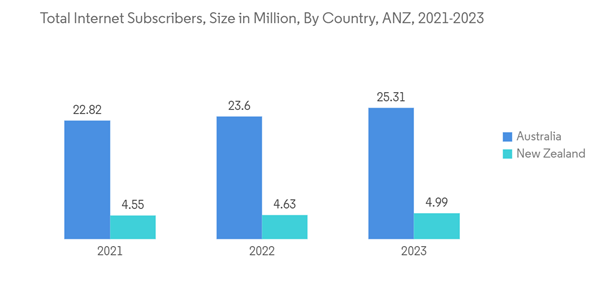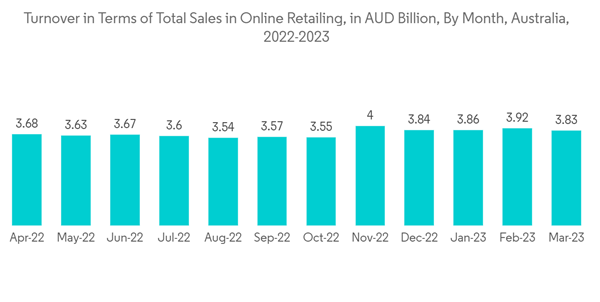The ANZ Location-based Services Market size is estimated at USD 2.07 billion in 2024, and is expected to reach USD 4.89 billion by 2029, growing at a CAGR of 18.81% during the forecast period (2024-2029).
In June 2023, DCS Spatial Services and FrontierSI, a non-profit organization, unveiled a strategic partnership aimed at reducing costs, mitigating risks, and addressing challenges associated with location-based reporting within the New South Wales (NSW) Government. This initiative seeks to assess an optimal strategy and offer recommendations for establishing a standardized and efficient solution for location-based reports across NSW, with potential implications at a national level.
In November 2022, global technology company GMV, in collaboration with Lockheed Martin Corporation, a prominent global technology firm, is set to develop the Southern Positioning Augmentation Network system (SouthPAN). This cooperative project, supported by the Australian and New Zealand governments, has the objective of establishing a satellite-based augmentation system (SBAS) for navigation and precise point positioning (PPP) services. Additionally, GMV will be responsible for monitoring and ensuring compliance with agreed-upon performance standards for both of these services in the region.
This product will be delivered within 2 business days.
Key Highlights
- Ongoing advancements like GPS technology, indoor positioning systems (IPS), and augmented reality (AR) are expected to enhance the accuracy and capabilities of location-based services, making them more attractive to businesses and consumers and contributing to market growth in the coming years.
- Satellite and positioning technologies are utilized regularly in almost all areas of modern life for people in Australia and New Zealand. More accurate positioning technology increases the efficiency of companies and improves the quality of life in a variety of areas, including air traffic control and instructions to the grocery.
- The ANZ (Australia and New Zealand) location-based services market is experiencing significant growth and transformation due to a convergence of technological advancements, changing consumer behaviors, and industry-specific demands. This market encompasses a wide range of services and applications leveraging location data to deliver personalized experiences, streamline business operations, and enhance everyday life.
- One of the primary drivers of the ANZ location-based services market is the widespread adoption of smartphones and other mobile devices. With a high smartphone penetration rate in Australia and New Zealand, the region provides a favorable environment for location-based apps and services. Consumers use these devices for navigation, local search, and location-aware applications, creating a substantial user base for location-based offerings.
- In addition, the transport and logistics industry benefits significantly from location-based services for route optimization, fleet management, and real-time tracking. As this sector expands to meet growing demand, the need for such services continues to rise.
- While location technology has improved, accuracy and reliability can still be a concern, especially in remote or densely populated areas. Inaccurate location data can lead to suboptimal user experiences and reduce the effectiveness of location-based services.
- Further, the pandemic accelerated the adoption of contactless services and touchless transactions. Moreover, in April 2020, Australia introduced its COVIDSafe app, which had one million downloads on the first day. At the end of the first week, the app had been downloaded by almost four million users. The Chief Medical Officer of Australia and the government recognized the COVIDSafe app as a crucial tool for accelerating contact tracing, enabling lockdown limitations, and easing the transition for Australians back to normal life. In addition, location-based services, such as mobile payment apps and contactless ordering at restaurants and stores, saw increased usage as people looked for safer, more convenient ways to conduct transactions.
ANZ Location-based Services Market Trends
Rapid Increase in Internet Penetration to Drive the Market Growth
- The rise of mobile devices, especially smartphones and tablets, is closely connected to the increase in internet usage. These widespread gadgets come equipped with built-in location-based technologies like GPS, making them ideal platforms for location-based services. The convenience of accessing such services further enhances their utility, creating a seamless experience for users who rely on real-time location information.
- Moreover, according to DataReportal, in January 2023, Australia was reported to have 25.31 million internet users with around 96.2% internet penetration rate, while in New Zealand, internet users were 4.99 million with a 95.9% penetration rate. Such a significant level of internet adoption indicates a considerable portion of the population is connected and can readily access location-based apps and solutions.
- ANZ has witnessed a proliferation of mobile applications catering to diverse needs, from navigation to social networking, e-commerce, and more. Many of these apps naturally incorporate location-based features, thereby popularizing location-based services. Consumers have grown accustomed to the convenience of these apps, which have become an integral part of their digital lives.
- Moreover, social media platforms have been quick to embrace location-based features as well. Users can check in at specific locations, share their locations, and discover events and businesses in their vicinity. These features promote user engagement and interaction, demonstrating the relationship between social networking and location-based services.
- In addition, incorporating location-based services into the Internet of Things (IoT) ecosystem is expected to be an emerging trend in driving location-based services by utilizing enhanced network connectivity. IoT devices rely on internet connectivity to communicate and share data, and location-based services are integral to various IoT applications, including asset tracking, smart home automation, and environmental monitoring.
Retail and Consumer Goods Segment is Expected to Hold a Significant Market Share
- Location-based services empower retailers to deliver highly targeted and personalized marketing campaigns to consumers. By analyzing location data, retailers can send real-time offers, discounts, and promotions to customers near or inside a physical store. This level of personalization significantly enhances the chances of conversion and customer loyalty.
- In addition, location-based services enable retailers to provide customers with accurate store locators and indoor navigation assistance within shopping malls or large retail outlets. This simplifies the shopping experience, helping customers find products more efficiently and enhancing overall satisfaction.
- Also, location-based services bridge the gap between physical and online shopping. Retailers can use these services to offer click-and-collect options, where customers can order online and pick up products in-store, promoting a seamless omnichannel shopping experience.
- Moreover, according to the Australian Bureau of Statistics, in March 2023, the turnover in terms of total sales was recorded to reach around AUD 3.83 billion (USD 2.873 billion), a 2.68% growth from the same month in the previous year. Moreover, the turnover achieved significant value in November 2022, reaching AUD 4 billion (USD 3 billion). With the Retail and Consumer Goods sector experiencing steady growth and considerable turnover, there is a strong push for businesses in this industry to invest in technologies that can strengthen their sales and customer engagement efforts.
- Further, location data can be used to optimize inventory management. Retailers can track the movement of products within their stores, ensuring items are restocked when and where needed. This minimizes stockouts, improves supply chain efficiency, and enhances the customer experience.
ANZ Location-based Services Industry Overview
The ANZ location-based services market is anticipated to witness moderate consolidation due to the presence of both international and local firms making substantial contributions to market share. Key industry players in this market comprise renowned companies such as Google LLC, Microsoft Corporation, Apple Inc., Huawei Technologies Co. Ltd, Cisco Systems, Inc., and others.In June 2023, DCS Spatial Services and FrontierSI, a non-profit organization, unveiled a strategic partnership aimed at reducing costs, mitigating risks, and addressing challenges associated with location-based reporting within the New South Wales (NSW) Government. This initiative seeks to assess an optimal strategy and offer recommendations for establishing a standardized and efficient solution for location-based reports across NSW, with potential implications at a national level.
In November 2022, global technology company GMV, in collaboration with Lockheed Martin Corporation, a prominent global technology firm, is set to develop the Southern Positioning Augmentation Network system (SouthPAN). This cooperative project, supported by the Australian and New Zealand governments, has the objective of establishing a satellite-based augmentation system (SBAS) for navigation and precise point positioning (PPP) services. Additionally, GMV will be responsible for monitoring and ensuring compliance with agreed-upon performance standards for both of these services in the region.
Additional Benefits:
- The market estimate (ME) sheet in Excel format
- 3 months of analyst support
This product will be delivered within 2 business days.
Table of Contents
1 INTRODUCTION
4 MARKET INSIGHTS
5 MARKET DYNAMICS
6 MARKET SEGMENTATION
7 COMPETITIVE LANDSCAPE
Methodology

LOADING...










